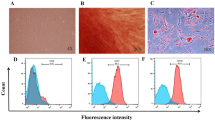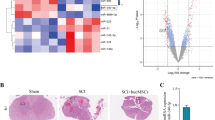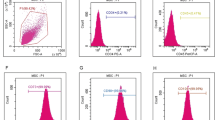Abstract
Study design:
Randomized, double-blinded animal experiment for neural functional recovery from spinal cord injury (SCI) through vaccination with immature dendritic cells (DCs) pulsed with homogenate protein of spinal cord (hpDCs) in mice.
Objective:
To study the effect of hpDCs in the recovery from SCI in mice.
Method:
Immature DCs pulsed with homogenate protein of spinal cord, myelin basic protein (MBP) or phosphate-buffer solution (PBS) were injected into spinal cord-injured mice locally or peritoneally. The functional recovery of spinal cord (open-field locomotor rating scale of Basso, Beattie and Bresnahan, BBB score) was measured weekly. The areas of injured region and cyst as well as the thickness of the glial scar were measured and the expressions of glial fibrillary acidic protein, neurofilament and nestin were detected to confirm the BBB scores.
Results:
Eighty-four days after injection, the BBB score of the hpDCs group (peritoneally injected mice) reached 18.2±1.1, significantly higher than that the scores of the mbpDCs and control groups (16.3±2.1 and 10.0±2.0, respectively). The areas of injured region and cyst as well as the thickness of the glial scar of the hpDCs group were less than that of the control group. Meanwhile, the expression of nestin lasts up to 56 days after injection in the hpDCs group, while it disappeared in the mbpDCs and PBS groups.
Conclusion:
Implanting DCs pulsed with homogenate protein of spinal cord, but not mbpDCs or PBS alone, locally or peritoneally, have a significant effect on functional recovery and neural preservation from SCI.
Similar content being viewed by others
Log in or create a free account to read this content
Gain free access to this article, as well as selected content from this journal and more on nature.com
or
References
Faden AI . Experimental neurobiology of central nervous system trauma. Crit Rev Neurobiol 1993; 7: 175–186.
Brewer KL, Bethea JR, Yezierski RP . Neuroprotective effects of interleukin-10 following excitotoxic spinal cord injury. Exp Neurol 1999; 159: 483–493.
Hauben E, Nevo U, Yole E, Moalen G, Agranov E, Mor F et al. Autoimmune T cells as potential neuroprotective therapy for spinal cord injury. Lancet 2000; 355: 286–287.
Moalem G, Leibowitz-Amit R, Yoles E, Mor F, Cohen IR, Schwartz M . Autoimmune T cells protect neurons from secondary degeneration after central nervous system axotomy. Nat Med 1999; 5: 49–55.
Hauben E, Butovsky O, Nevo U, Yoles E, Moalem G, Agranov E et al. Passive or active immunization with myelin basic protein promotes recovery from spinal cord contusion. Neurosci 2000; 20: 6421–6430.
Franzen R, Schoenen J, Leprince P, Joosten E, Moonen G, Martin D . Effects of macrophage transplantation in the injured adult rat spinal cord: a combined immunocytochemical and biochemical study. Neurosci Res 1998; 51: 316–327.
Mellman I, Steinman RM . Dendritic cells: specialized and regulated antigen processing machines. Cell 2001; 106: 255–258.
Hauben E, Gothilf A, Cohen A, Butovsky O, Nevo U, Smirnov I et al. Vaccination with dendritic cells pulsed with peptides of myelin basic protein promotes functional recovery from spinal cord injury. Neurosci 2003; 23: 8808–8819.
Fehlings MG, Nashmi R . Assessment of axonal dysfunction in an in vitro model of acute compressive injury to adult rat spinal cord axons. Brain Res 1995; 677: 291–299.
Lutz MB, Kukutsch N, Ogilvie AL . An advanced culture method for generating large quantities of highly pure dendritic cells from mouse bone marrow. Immunol Methods 1999; 223: 77–92.
Brandt HM, Apkarian AV . Biotin-dextran: a sensitive anterograde tracer for neuroanatomic studies in rat and monkey. Neurosci Methods 1992; 45: 35–40.
Strominger RN, McGiffen JE, Strominger NL . Morphometric and experimental studies of the red nucleus in the albino rat. Anat Rec 1987; 219: 420–428.
Schwartz M, Moalem G, Leibowitz-Amit R, Cohen IR . Innate and adaptive immune responses can be beneficial for CNS repair. Trends Neurosci 1999; 22: 295–299.
McMenamin PG . Distribution and phenotype of dendritic cells and resident tissue macrophages in the dura mater, leptomeninges, and choroid plexus of the rat brain as demonstrated in wholemount preparations. Comp Neurol 1999; 405: 553–562.
Yoles E, Hauben E, Palgi O, Agranov E, Gothilf A, Cohen A et al. Protective autoimmunity is a physiological response to CNS trauma. Neurosci 2001; 21: 3740–3748.
Schwartz M, Moalem G, Leibowitz-Amit R, Cohen IR . Innate and adaptive immune responses can be beneficial for CNS repair. Trends Neurosci 1999; 22: 295–299.
Moalem G, Leibowitz-Amit R, Yoles E, Mor F, Cohen IR, Schwartz M . Autoimmune T cells protect neurons from secondary degeneration after central nervous system axotomy. Nat Med 1999; 5: 49–55.
Hauben E, Mizrahi T, Agranov E, Schwartz M . Sexual dimorphism in the spontaneous recovery from spinal cord injury: a gender gap in beneficial autoimmunity? Eur J Neurosci 2002; 16: 1731–1740.
Nevo U, Hauben E, Yoles E, Agranov E, Akselrod S, Schwartz M et al. Diffusion anisotropy MRI for quantitative assessment of recovery in injured rat spinal cord. Magn Reson Med 2001; 45: 1–9.
Rapalino O, Lazarov-Spiegler O, Agranov E, Velan GJ, Yoles E, Fraidakis M et al. Implantation of stimulated homologous macrophages results in partial recovery of paraplegic rats. Nat Med 1998; 4: 814–821.
Author information
Authors and Affiliations
Corresponding authors
Rights and permissions
About this article
Cite this article
Liu, M., Zhao, J., Liang, H. et al. Vaccination with dendritic cells pulsed with homogenate protein of spinal cord promotes functional recovery from spinal cord injury in mice. Spinal Cord 47, 360–366 (2009). https://doi.org/10.1038/sc.2008.112
Received:
Revised:
Accepted:
Published:
Issue date:
DOI: https://doi.org/10.1038/sc.2008.112



